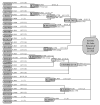Improved Models of Coalescence Ages of Y-DNA Haplogroups
- PMID: 34200049
- PMCID: PMC8228294
- DOI: 10.3390/genes12060862
Improved Models of Coalescence Ages of Y-DNA Haplogroups
Abstract
Databases of commercial DNA-testing companies now contain more customers with sequenced DNA than any completed academic study, leading to growing interest from academic and forensic entities. An important result for both these entities and the test takers themselves is how closely two individuals are related in time, as calculated through one or more molecular clocks. For Y-DNA, existing interpretations of these clocks are insufficiently accurate to usefully measure relatedness in historic times. In this article, I update the methods used to calculate coalescence ages (times to most-recent common ancestor, or TMRCAs) using a new, probabilistic statistical model that includes Y-SNP, Y-STR and ancilliary historical data, and provide examples of its use.
Keywords: human Y chromosome; male history; molecular clock; time estimation.
Conflict of interest statement
The author declares prior, unfunded consultancy work and ongoing collaboration with the commercial DNA testing company Gene by Gene Ltd., Houston, TX, USA. Neither this company nor its staff had a role in the design of the study; in the collection, analyses, or interpretation of data; in the writing of the manuscript, or in the decision to publish the results.
Figures




Similar articles
-
Toward a consensus on SNP and STR mutation rates on the human Y-chromosome.Hum Genet. 2017 May;136(5):575-590. doi: 10.1007/s00439-017-1805-8. Epub 2017 Apr 28. Hum Genet. 2017. PMID: 28455625 Review.
-
Genetic Reconstruction and Forensic Analysis of Chinese Shandong and Yunnan Han Populations by Co-Analyzing Y Chromosomal STRs and SNPs.Genes (Basel). 2020 Jul 3;11(7):743. doi: 10.3390/genes11070743. Genes (Basel). 2020. PMID: 32635262 Free PMC article.
-
A new future of forensic Y-chromosome analysis: rapidly mutating Y-STRs for differentiating male relatives and paternal lineages.Forensic Sci Int Genet. 2012 Mar;6(2):208-18. doi: 10.1016/j.fsigen.2011.04.017. Epub 2011 May 25. Forensic Sci Int Genet. 2012. PMID: 21612995
-
A game of hide and seq: Identification of parallel Y-STR evolution in deep-rooting pedigrees.Eur J Hum Genet. 2019 Apr;27(4):637-646. doi: 10.1038/s41431-018-0312-2. Epub 2018 Dec 20. Eur J Hum Genet. 2019. PMID: 30573800 Free PMC article.
-
[Y-chromosome analysis].J Soc Biol. 2003;197(4):333-6. J Soc Biol. 2003. PMID: 15005513 Review. French.
References
-
- Nordtvedt K. More Realistic TMRCA Calculations. J. Genet. Geneal. 2008;4:96–103.
-
- Wilson I.J., Weale M.E., Balding D.J. Inferences from DNA data: Population histories, evolutionary processes and forensic match probabilities. J. R. Stat. Soc. Ser. Stat. Soc. 2003;166:155–188. doi: 10.1111/1467-985X.00264. - DOI
-
- Adamov D., Gurianov V.M., Karzhavin S., Tagankin V., Urasin V. Defining a New Rate Constant for Y-Chromosome SNPs based on Full Sequencing Data. Russ. J. Genet. Geneal. 2015;7:68–82.
MeSH terms
LinkOut - more resources
Full Text Sources

